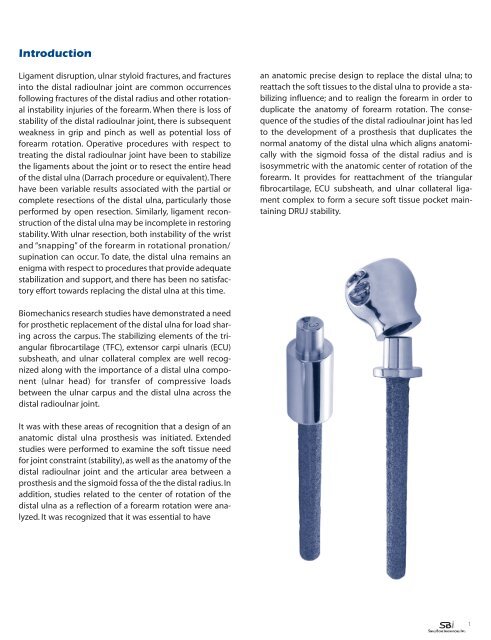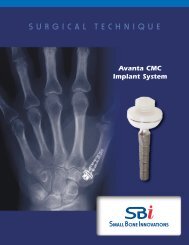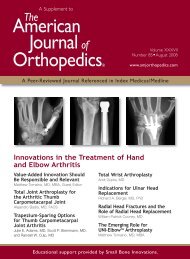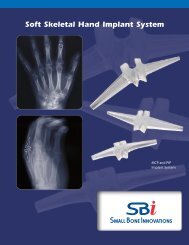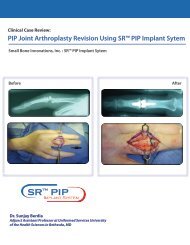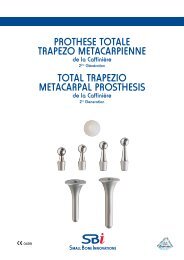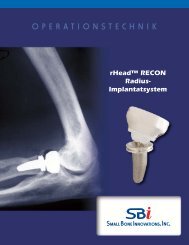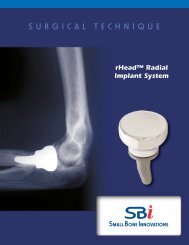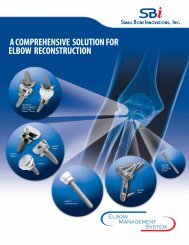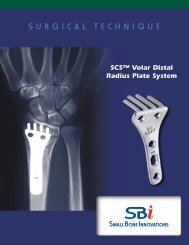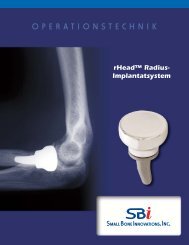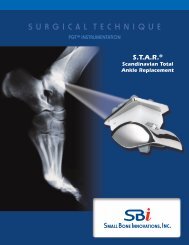Download the uHead Surgical Technique - Small Bone Innovations
Download the uHead Surgical Technique - Small Bone Innovations
Download the uHead Surgical Technique - Small Bone Innovations
You also want an ePaper? Increase the reach of your titles
YUMPU automatically turns print PDFs into web optimized ePapers that Google loves.
Introduction<br />
Ligament disruption, ulnar styloid fractures, and fractures<br />
into <strong>the</strong> distal radioulnar joint are common occurrences<br />
following fractures of <strong>the</strong> distal radius and o<strong>the</strong>r rotational<br />
instability injuries of <strong>the</strong> forearm. When <strong>the</strong>re is loss of<br />
stability of <strong>the</strong> distal radioulnar joint, <strong>the</strong>re is subsequent<br />
weakness in grip and pinch as well as potential loss of<br />
forearm rotation. Operative procedures with respect to<br />
treating <strong>the</strong> distal radioulnar joint have been to stabilize<br />
<strong>the</strong> ligaments about <strong>the</strong> joint or to resect <strong>the</strong> entire head<br />
of <strong>the</strong> distal ulna (Darrach procedure or equivalent).There<br />
have been variable results associated with <strong>the</strong> partial or<br />
complete resections of <strong>the</strong> distal ulna, particularly those<br />
performed by open resection. Similarly, ligament reconstruction<br />
of <strong>the</strong> distal ulna may be incomplete in restoring<br />
stability. With ulnar resection, both instability of <strong>the</strong> wrist<br />
and “snapping” of <strong>the</strong> forearm in rotational pronation/<br />
supination can occur. To date, <strong>the</strong> distal ulna remains an<br />
enigma with respect to procedures that provide adequate<br />
stabilization and support, and <strong>the</strong>re has been no satisfactory<br />
effort towards replacing <strong>the</strong> distal ulna at this time.<br />
an anatomic precise design to replace <strong>the</strong> distal ulna; to<br />
reattach <strong>the</strong> soft tissues to <strong>the</strong> distal ulna to provide a stabilizing<br />
influence; and to realign <strong>the</strong> forearm in order to<br />
duplicate <strong>the</strong> anatomy of forearm rotation. The consequence<br />
of <strong>the</strong> studies of <strong>the</strong> distal radioulnar joint has led<br />
to <strong>the</strong> development of a pros<strong>the</strong>sis that duplicates <strong>the</strong><br />
normal anatomy of <strong>the</strong> distal ulna which aligns anatomically<br />
with <strong>the</strong> sigmoid fossa of <strong>the</strong> distal radius and is<br />
isosymmetric with <strong>the</strong> anatomic center of rotation of <strong>the</strong><br />
forearm. It provides for reattachment of <strong>the</strong> triangular<br />
fibrocartilage, ECU subsheath, and ulnar collateral ligament<br />
complex to form a secure soft tissue pocket maintaining<br />
DRUJ stability.<br />
Biomechanics research studies have demonstrated a need<br />
for pros<strong>the</strong>tic replacement of <strong>the</strong> distal ulna for load sharing<br />
across <strong>the</strong> carpus. The stabilizing elements of <strong>the</strong> triangular<br />
fibrocartilage (TFC), extensor carpi ulnaris (ECU)<br />
subsheath, and ulnar collateral complex are well recognized<br />
along with <strong>the</strong> importance of a distal ulna component<br />
(ulnar head) for transfer of compressive loads<br />
between <strong>the</strong> ulnar carpus and <strong>the</strong> distal ulna across <strong>the</strong><br />
distal radioulnar joint.<br />
It was with <strong>the</strong>se areas of recognition that a design of an<br />
anatomic distal ulna pros<strong>the</strong>sis was initiated. Extended<br />
studies were performed to examine <strong>the</strong> soft tissue need<br />
for joint constraint (stability), as well as <strong>the</strong> anatomy of <strong>the</strong><br />
distal radioulnar joint and <strong>the</strong> articular area between a<br />
pros<strong>the</strong>sis and <strong>the</strong> sigmoid fossa of <strong>the</strong> <strong>the</strong> distal radius. In<br />
addition, studies related to <strong>the</strong> center of rotation of <strong>the</strong><br />
distal ulna as a reflection of a forearm rotation were analyzed.<br />
It was recognized that it was essential to have<br />
1


